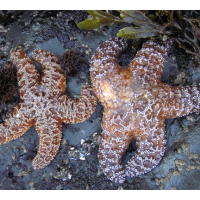Scientists Think They Found the Virus Wiping out Starfish on the West Coast

Scientists say the massive, mysterious die-off of starfish all along the West Coast this past year and a half was probably caused by a virus that has been around in a mostly dormant state since at least 1942.
A study published in the Proceedings of the National Academy of Sciences by an international team of researchers sorted through the 10 million or so viruses contained in a drop of seawater to isolate the sea star-associated densovirus (SsaDV) thought to be responsible for melting the limbs of starfish by the millions.
Using DNA sequencing and other analyses of potential pathogens, the scientists settled on a likely prospect and testing of the virus provided quick and disgusting confirmation.
Researchers found the virus all over the place: in sick starfish, healthy starfish, 20 varieties of starfish, seawater, sediment, sea urchins and 70-year-old museum specimens. That raises a number of questions, including: why now?
Global warming could very likely have something to do with that.
Cornell University marine epidemiologist Drew Harvell, noting that the disease progressed much more quickly in warm water, said during the summer, “A warmer world would be a sicker world. Under warming conditions a lot of microorganisms do better. They grow faster. They replicate faster. Many of our hosts can actually be stressed by warm conditions. And so it kind of creates a perfect storm of sickness.”
Warmer water is an obvious target when looking for a virus trigger, although the virus continued to spread during the winter of 2013-14, when the oceans cooled. But man’s assault on Mother Nature in the Industrial Age extends beyond heating up the seven seas. The oceans are also more acidic, and acidification has been shown to stress starfish and slow their growth.
The storm’s beginnings were first noticed in Vancouver, Canada, and Washington State in June 2013 and dumbfounded scientists who had seen similar, smaller outbreaks in much warmer waters, usually spurred by an approaching El Niño. Toward the end of the year, dead starfish were washing up in Southern California and locations in between.
The starfish develop white lesions, which sometimes become ulcerous, before the disintegration begins. Limbs start falling off within days or weeks. “The sick ones tend to just fall apart in front of your eyes,” Vancouver Aquarium biologist Jeff Marliave said. “An arm will actually break off and crawl away. They turn into goo.”
Starfish are a keystone species, critical to the ecological balance in areas they flourish. They devour mussels and other creatures known for dominating their ecosystems to the detriment of other species.
Identifying the virus doesn’t necessarily get scientists all that much closer to solving the problem. They don’t know if the virus has suddenly evolved into a more potent form or outside sources are steering its direction. They can’t say for sure how the virus is transmitted (too many possibilities) and don’t know why some creatures that encounter it, like urchins, appear to be unscathed.
Researchers in some locations have recently noticed far more juvenile starfish than usual, prompting speculation that starfish saw disaster coming and procreated like crazy. It’s possible the burst of reproduction could rebuild the starfish population in a short while, or the scourge could wipe out a big chunk of the next generation.
Pathogens tend not to entirely wipe out the host that makes their existence possible. That would be counterproductive, and considered kinda nuts if humans did something like that with their host.
–Ken Broder
To Learn More:
In Search of the Starfish Killer: The Quest to Save the Original Keystone Species (by Elizabeth Lopatto, The Verge)
Scientists Solve Mystery of West Coast Starfish Plague (by Katie Campbell, KTCS9 in Seattle)
Mysterious Killer of Starfish Identified (by Peter Fimrite, San Francisco Chronicle)
“Perfect Storm of Sickness” That Is Dissolving Starfish Spreads South to San Diego (by Ken Broder, AllGov California)
- Top Stories
- Controversies
- Where is the Money Going?
- California and the Nation
- Appointments and Resignations
- Unusual News
- Latest News
- California Forbids U.S. Immigration Agents from Pretending to be Police
- California Lawmakers Urged to Strip “Self-Dealing” Tax Board of Its Duties
- Big Oil’s Grip on California
- Santa Cruz Police See Homeland Security Betrayal in Use of Gang Roundup as Cover for Immigration Raid
- Oil Companies Face Deadline to Stop Polluting California Groundwater





